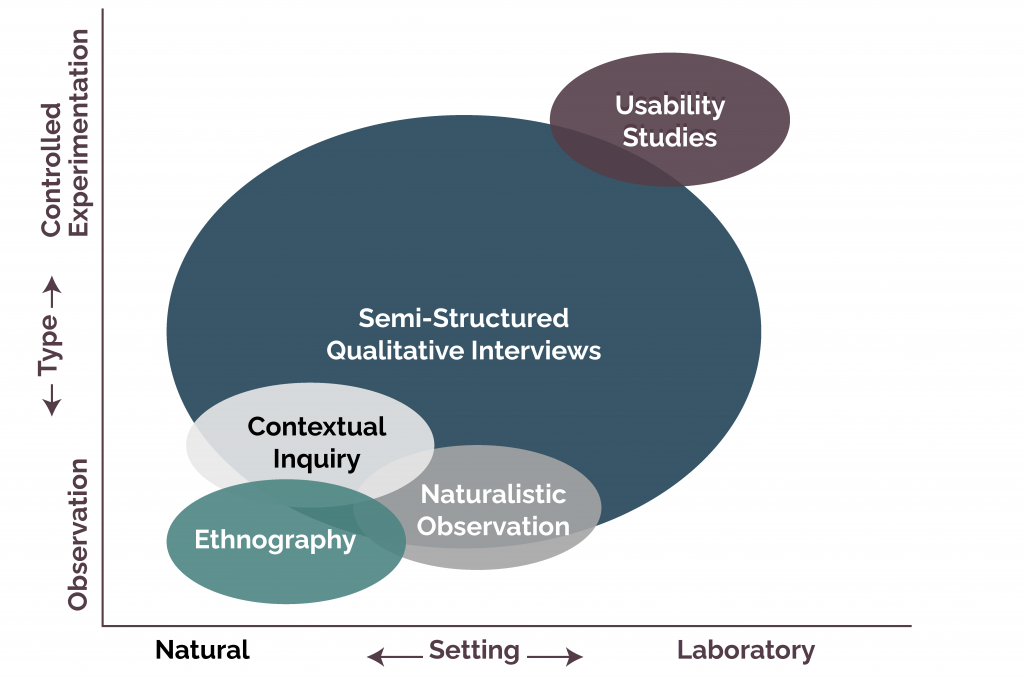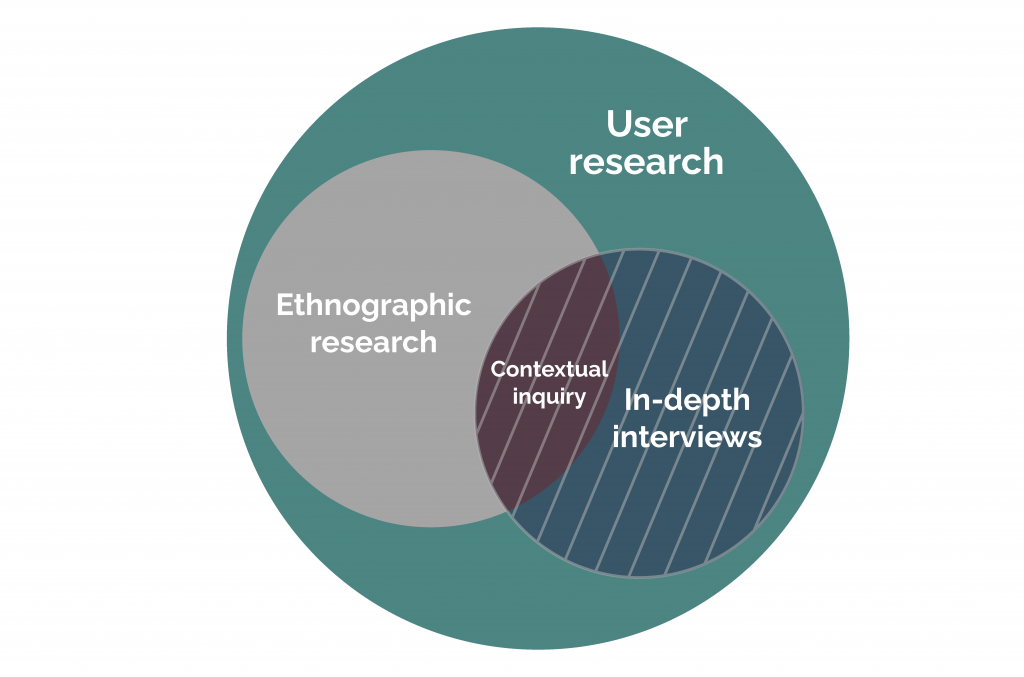Given the overarching function of user experience research (UXR) in bringing end-users’ needs to design conversations, a research method based on direct observation of current workflows offers a powerful way of understanding those needs. Contextual inquiry is such a method; it involves direct observations of and conversations about workflows with subject matter experts or other workers who perform the work that a product is designed to improve. The purpose of a contextual inquiry is to understand how a process or workflow works “in the field.” Rather than how it is supposed or believed to work by rule-makers. Contextual inquiry differs from the standard usability test. The researcher observes and asks the participant to talk through existing processes rather than testing the intuitiveness of processes or usability of features. Contextual inquiry and usability testing are complementary, with the former being used before or at the beginning of the design process. The latter is used well in the design process when a prototype has been developed.

Bubble graph comparing contextual inquiry to other research methods.
When to Conduct Contextual Inquiry?
Because contextual inquiry is useful for exposing pain points and needs in current processes, it is a beneficial method to employ at the beginning of a project’s design phase or even in a pathfinding research project. Incorporating contextual inquiry at the beginning of the design phase is very useful in refining an existing idea or concept to ensure it will help its intended users or customer base. A pathfinding project occurs when research is conducted earlier in the project, and the findings on user needs and pain points are used to decide what to build at the concept level. For example, a company wanting to make a parking app for couriers might use contextual inquiry to dial in the idea to be optimally suited for parking needs. Alternatively, the company could do pathfinding research that incorporated contextual inquiry into exploring how documents and other essential things move between its client and their customers. Then, use the findings on needs and pain points to decide if the company should build a parking app or an app that makes electronic document transfer easier, eliminating the need for parking of paying couriers mileage.
In addition to using contextual inquiry at the beginning of or before the design phase, a UX or CX team can incorporate it into UXR for a redesign project. The unit can discover the pain points of using the current version of an application, platform, or other product as part of the next iteration process.
Benefits of Contextual Inquiry
The specific benefits of incorporating contextual inquiry into a research plan include the level of detail in the data (thick data), a people-centered approach, and its high-quality insights on how workflows or processes work in real settings.
Thick Data: Contextual inquiry yields data with fine-grained detail for two reasons. First, the qualitative nature of the observation and interview data gleaned from contextual inquiry means that the researcher can dive deeper into each participant’s unique experience rather than fit that experience onto limited answer choices in a survey. Second, contextual inquiry incorporates direct observation of a work setting and process means that the research findings are more profound and more richly informed by context.
People-centered: The need for empathy and a partnership model for a contextual inquiry to work assures that it centers the researcher on the people who are the target audience of technology rather than on the proposed technology itself. This research method’s nature means that researchers are thoroughly grounded in potential users’ full context and will keep their needs front and center when they link back with the product team.
Real Settings: The “in the wild” field setting of contextual inquiry ensures that it captures how things are done, rather than how they are supposed to be done according to executives’ understanding or SOP. Think of a contextual inquiry as equivalent to getting to know a nature park or city by actually walking around and exploring, not assuming one knows the place simply because one reviewed the map.
How to Conduct Contextual Inquiries
At a basic level, one conducts a contextual inquiry by observing a process from start to finish and concurrently talking about it with the person who uses the process. Kim Salazar from the Nielsen Norman group outlines a “master and apprentice” model. The SME or other potential user is the master with in-depth process knowledge who instructs the researcher-as-apprentice through showing and talking about the process. Usually, the contextual inquiry takes a “think aloud” approach, where the participant describes each step of the process while doing. The researcher asks questions along the way and may prompt with reminders to think aloud as needed. The UXR session may include a concluding interview after the process is done to ask about the overall attitude toward the current process and surface perceived pain points that may not be apparent from observation. Another variant involves a more passive approach of quietly observing the process and holding the interview questions until after the procedure is concluded. If possible, it is better to make a contextual inquiry as a team of two. The first researcher acts as the moderator and runs the session. The second researcher acts as a note-taker, and the digital recorder troubleshoots issues and asks follow-up questions if need be. Methods of turning the observations and dialogue into data include writing detailed notes, video recording, still photos, or another device if appropriate.

Example of a contextual inquiry session.
Principles for Conducting a Contextual Inquiry
During a contextual inquiry session, it is essential to keep four principles in mind. These principles are context, partnership, mutual interpretation, and focus.
Context: As the name implies, the context of the workflow is critical to the contextual inquiry. It is imperative to collect data in the site where the work is done, not in a lab. The ideal approach is for the researcher to travel to the site and be physically present during the UXR session. If physical presence is not possible, then virtual presence may substitute via screen share or a virtual tour (more on these approaches later); it is also possible in some cases to collect data via sensors to complement the interview portion.
Partnership: The ideal partnership between researcher and participant stands in contrast to more traditional data collection methods such as surveys. Instead of the researcher having complete control of an artificial situation where the participant is treated as a mere datapoint without agency, the researcher must engage the participant in a mutual learning and sharing experience. The researcher should be flexible and receptive to hearing what the participant has to say, even if it is not strictly according to the interview guide’s script.
Mutual Interpretation: The researcher should develop a shared interpretation of the workflow or process with the participant. This is where “think aloud” and the conversational aspect of the method takes on great importance. A researcher should also periodically interpret what the participant says back to the participant to ensure mutual understanding. Remember, the participant is the expert on the workflow.
Focus: the researcher should have a clear idea of the project’s overall goal and what research questions or problems need to be answered or solved to ensure that the findings are relevant.
Anatomy of a Contextual Inquiry Session
A contextual inquiry session has three parts, the introduction, the interview itself, and the wrap-up.
Introduction: The introduction is where the moderator introduces the research team, describes the session’s purpose, and outlines what information they hope to glean from the session. It is best to start by thanking the participant for taking the time to share knowledge about the workflow. The moderator should also give the participant a chance to ask questions before launching into the next phase. The introduction is key to building rapport between the researcher and the participant. It should conclude with a transition that describes the interview stages and what the researcher will do or ask for next.
Interview: Starting with a brief instruction to show the research team the process and think aloud while the moderator asks the participant to do a “walk through” of the typical workflow of interest. The moderator should ask questions about any step that they do not understand and may also give gentle reminders to think aloud if the participant forgets. After the process is completed, the interview may conclude with questions about the participant’s overall impression of the process, particularly pain points. The interview complements the observation phase by surfacing thoughts or emotions that may not be apparent in the observation phase. In all phases, the researcher(s) should do more listening than talking. Before proceeding to the wrap-up, give a broad-brush summary of the whole process or the process’s purpose to ensure mutual understanding.
Wrap Up: This phase starts by informing the participant that the interview is concluded and the session is coming to a close. This is the time to thank the participant once again for taking the time to share insights and build a better product. It may be appropriate to ask if the research team may contact the participant for future sessions. In B2C projects where there is an incentive for participation, be sure to give it to the participant or provide the information on how to redeem it.
Contextual Inquiry as Part of a Mixed Methodology
Depending on the business goal and research problem, the contextual inquiry may be used as a stand-alone method or as part of a broader mixed methods approach. Examples of contextual inquiry in mixed methodology include:
- Embed contextual inquiry in a broader ethnography of a workplace, working group, or organization.
- Complement data on app usability from the system usability scale (SUS) with a contextual inquiry of a typical “day in the life” of a workflow or process.
- Embed contextual inquiry in a semi-structured interview about workflow processes.
Contextual inquiry adds rich data about user experience to data streams from other qualitative UXR methods and quantitative data on overall trends.

Venn diagram of how Contextual Inquiry fits into UXR Methodology.
Considerations for making Contextual Inquiry in an Enterprise Setting
While contextual inquiry in a B2C, a customer-facing context may be used to build or redesign a product to market to external customers to improve workflows. The specific goal of contextual inquiry for enterprise software or other internally oriented project is to enhance the process of serving external customers. Making contextual inquiry in an enterprise setting involves special considerations, including an operational focus, the importance of internal stakeholders, the importance of getting buy-in from the right people, and the tyranny of time.
Operational Focus: The project for which contextual inquiry is used to collect data could be focused on a wide array of work processes beyond marketing and sales, including production, operations, logistics, or administration workflows. The final solution to the business problem might have commonalities with other projects. It will still be unique to a specific enterprise’s business problems, unlike a customer-facing solution, which may be mass-deployed across many external customers.
Internal Stakeholders: A UXR project in an enterprise setting may involve many internal stakeholders, including executives, functional team leads, and individual contributors. These stakeholders may be concentrated in one active area or vertical or spread across several. It is crucial to identify how the proposed technology may meet or conflict with each group’s needs. Identifying pertinent stakeholders and mapping them to the project’s overall business goal is vital to generating buy-in for the project and contextual inquiry from critical stakeholders.
Buy-in: One advantage of doing UXR for an internal enterprise client is that the recruitment effort is contained to a more limited subset of people. A corollary to this statement is that buy-in from key stakeholders is crucial to a successful contextual inquiry. Suppose an executive or functional leader does not see the value in the method or the research. In that case, it will be tough to get the necessary signoffs and introductions to get access to relevant SMEs to participate in research. Unlike recruitment in the general population, if crucial stakeholders say no, there is no-one else you can ask to participate in research.
Tyranny of Time: A major blocker to making contextual inquiry in an enterprise setting is the tyranny of time. Everyone is busy, and participating in research takes away from participants’ performance of actual work duties. Contextual inquiry takes logistical time and effort to set up and often needs more time for data collection than filling out a SUS or even semi-structured interviews. It is vital to make a case for the added value of contextual inquiry to justify the time needed to do it well.
Adapting Contextual Inquiry to the Covid-19 Pandemic
The current global COVID-19 pandemic and the concomitant need for social-distancing make traditional, in-person contextual inquiry is difficult or impossible to do. While this situation is a significant UXR blocker, it also presents an opportunity to learn about and experiment with digital methods of contextual inquiry, e.g., video conferencing apps like Zoom, WebEx, BlueJeans, etc. Though video conferencing makes it difficult to perceive analog, physical parts of workflows, it works well for focusing on digital steps and movements such as screens displayed, clicks, and mouse hovers. It is still possible for participants to “think aloud” and talk about the research team through what they are doing.
Due to the virtual nature of UXR in the current situation, screen-sharing of processes and workflows has become significant. There is an opportunity to focus on the user journey through a workflow for online work processes. Video conferencing software also provides a chance to obtain high-quality video recordings of screens during work processes.
In some cases, screen-share data can be complemented with a virtual tour of a workspace. In which the participant turns his or her camera on and records while taking a workspace walkthrough. A virtual tour is beneficial in the following situations:
- The workflow involves physical and digital processes.
- The participants use multiple devices or screens to complete the tasks.
- Any other situation where the physical setting or other aspects of participant surroundings provide useful context to the workflow.
Wrapping up
Contextual inquiry is a powerful method in a UXR toolkit to ensure a product team builds the right thing to meet users’ needs, thus maximizing the value proposition of the product being designed. One might think of UXR as shaping the headwaters of a river to go in the desired direction, with the successive stretches of the river being design, development, testing, and deployment. Even in an Agile environment, employing research early often ensures that each iteration improves the technology to be made. Contextual inquiry is a very effective method for optimizing the impact of UXR.
Radiant Digital has used contextual inquiry effectively on leading digital products and solutions.
Call us to learn how you could apply this during your next UX project.


